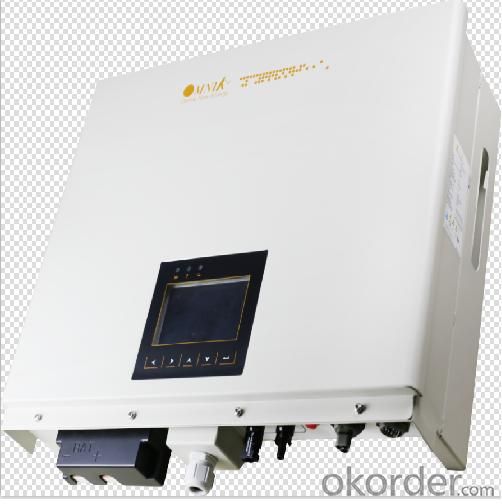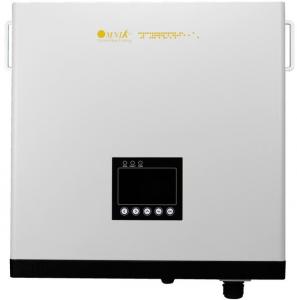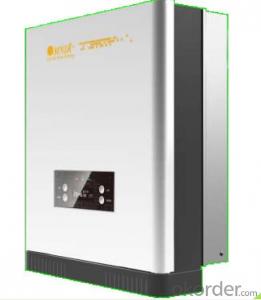480V On Grid Solar Inverter Omniksol-17k-TL
- Loading Port:
- Shanghai
- Payment Terms:
- TT or LC
- Min Order Qty:
- 100 pc
- Supply Capability:
- 3000 pc/month
OKorder Service Pledge
OKorder Financial Service
You Might Also Like
Omnik new energy solar inverter
Omniksol-2.0k-TL Photon Efficiency up to 3kW
in the world------ Photon tested Jan. 2012.
Omniksol-17k-TL
Futures
Max. Efficiency 98.2%, Euro. Efficiency 97.8%.
Double MPPT, MPPT accuracy up to 99.9%.
IP65 design, work properly under severe outdoor circumstances.
Full solution of safety protection, DC switch integrated.
Flexible input and output connections, support RS485, Ethernet
and USB communication.
Transformerless design and high power density, lighter and more
convenient for installation.
technical data:
Type | Omniksol-13k-TL | Omniksol-17k-TL | Omniksol-20k-TL |
Max. PV-Generator Power [W] | 13500 | 17600 | 21200 |
Max. DC voltage [V] | 1000 | 1000 | 1000 |
MPPT DC voltage Range [V] | 400-800 | 440-850 | 440-850 |
Turn off DC voltage [V] | 640 | 640 | 640 |
Max. DC Current [A] | 22/11 | 22/22 | 22/22 |
Nominal DC Current [A] | 28 | 33 | 33 |
Number of DC Connection | 2 | 2 | 2 |
DC-Connection | MC4 | MC4 | MC4 |
Number of MPP trackers Turn on Power [W] | 2 | 2 | 2 |
| Omniksol | |||

FAQ
Q1. What is the difference between inverter and solar inverter?
A1. Inverter only has AC inpput, but solar inverter both connect to AC input and solar panel, it saves more power.
Q2. What is the difference between MPPT&PWM?
A2. MPPT has higher efficiency, it can track the max power point and won't waste energy.
- Q: Can a solar inverter be upgraded or expanded?
- Yes, a solar inverter can be upgraded or expanded. Upgrades may involve adding new features or improving the efficiency of the existing inverter. Expansion typically refers to increasing the capacity of the inverter to accommodate additional solar panels. However, the extent to which an inverter can be upgraded or expanded varies depending on the specific model and manufacturer.
- Q: What happens to excess solar energy generated by the inverter?
- Excess solar energy generated by the inverter can be stored in batteries for later use or exported to the power grid, depending on the setup.
- Q: Can a solar inverter be used with different types of solar charge controllers?
- Yes, a solar inverter can be used with different types of solar charge controllers as long as they are compatible in terms of voltage and communication protocols. However, it is important to ensure that the solar inverter and charge controller are properly matched to ensure optimal performance and safety.
- Q: What are the signs of a faulty solar inverter?
- Some signs of a faulty solar inverter include a complete lack of power generation, inconsistent or fluctuating power output, error messages or fault codes displayed on the inverter, unusual or excessive noise coming from the inverter, and visual indicators such as flickering lights or abnormal behavior of connected devices.
- Q: Can a solar inverter be used in a solar-powered telecommunications system?
- Yes, a solar inverter can be used in a solar-powered telecommunications system. The solar inverter is responsible for converting the direct current (DC) produced by solar panels into alternating current (AC) that can be used to power various devices in the system, including telecommunications equipment.
- Q: What is the impact of a solar inverter on the overall system cost?
- The overall system cost can be significantly impacted by a solar inverter. An essential component of a solar power system, the solar inverter converts the direct current (DC) generated by solar panels into alternating current (AC) for powering electrical devices or feeding back into the grid. The cost of a solar inverter varies based on its capacity, efficiency, and brand. Generally, more advanced and efficient inverters tend to be pricier. However, investing in a high-quality inverter can lead to long-term savings and improved system performance. Considering the size of the solar power system is important. Inverters have capacity limits, so selecting the right-sized inverter is crucial for optimizing energy production and system efficiency. An undersized inverter can restrict performance, while an oversized one may result in unnecessary additional costs. The quality and reliability of the inverter are also significant factors. A well-built and reliable inverter can minimize maintenance and repair expenses, ensuring a longer lifespan for the solar power system. Furthermore, advanced features like monitoring capabilities and grid integration functionalities can enhance system performance and provide valuable maintenance and troubleshooting data, though they may increase overall system cost. Additionally, the efficiency of a solar inverter can impact the overall system cost. Higher efficiency inverters can convert more DC power into usable AC power, increasing energy production and potentially reducing the number of required solar panels. This can result in cost savings in terms of panel purchase and installation. In conclusion, while the cost of a solar inverter is an important factor in overall system cost, it is crucial to balance it with considerations such as capacity, efficiency, reliability, and additional features. Investing in a properly sized, high-quality inverter can lead to long-term savings, improved system performance, and higher energy production, maximizing the value and benefits of a solar power system.
- Q: Photovoltaic grid-connected inverter problem
- Hello, the definition of the zero line is not caused by the transformer three-phase electric tail connection? I now do not understand why there is no isolation transformer AC output marked is N (zero line), and it is not the transformer three-phase power of the tail connection leads to, this is the zero line? The The
- Q: What are the different output waveforms of a solar inverter?
- The different output waveforms of a solar inverter can vary depending on the type and design of the inverter. The most common output waveform is a modified sine wave, which is a stepped approximation of a true sine wave. However, some solar inverters can produce a pure sine wave output, which is an exact replication of the smooth sinusoidal waveform found in utility power. Additionally, there are also solar inverters that can produce a square wave or a quasi-square wave output waveform. The choice of output waveform depends on the specific application and the compatibility requirements of the connected appliances or equipment.
- Q: Can a solar inverter be used for commercial applications?
- Yes, a solar inverter can be used for commercial applications. Solar inverters are an essential component of commercial solar power systems, as they convert the direct current (DC) electricity generated by solar panels into alternating current (AC) electricity that can be used to power commercial buildings and equipment.
- Q: Are there any government incentives available for solar inverters?
- Many countries provide government incentives for solar inverters, aiming to promote renewable energy adoption and reduce carbon emissions. In the United States, for example, one common incentive is the solar investment tax credit (ITC), allowing homeowners and businesses to deduct a portion of their solar installation costs from their federal taxes. Germany, on the other hand, implements feed-in tariffs that require utility companies to pay a premium for electricity generated by solar inverters. Furthermore, local governments may offer grants, rebates, or low-interest loans to facilitate the purchase and installation of solar inverters. To fully grasp the incentives available in your region, it is crucial to consult your local government or relevant authorities.
Send your message to us
480V On Grid Solar Inverter Omniksol-17k-TL
- Loading Port:
- Shanghai
- Payment Terms:
- TT or LC
- Min Order Qty:
- 100 pc
- Supply Capability:
- 3000 pc/month
OKorder Service Pledge
OKorder Financial Service
Similar products
Hot products
Hot Searches
Related keywords

























